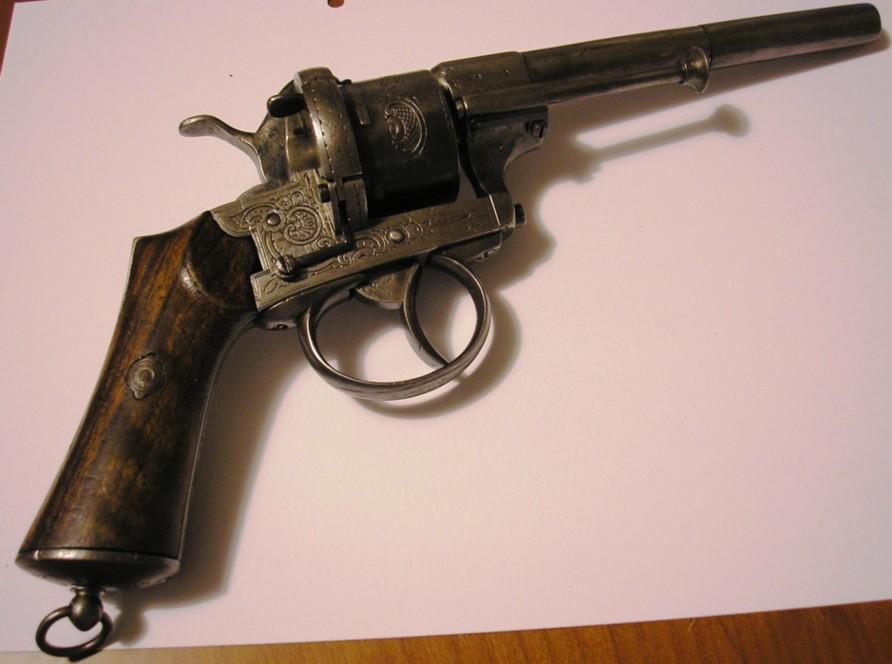Some of the most beautiful work of this craftsman, and many others, are in this book “Liège Gunmakers through their Work. 1800 - 1950”.
For more detail see: LIEGE GUNMAKERS
Lefaucheux-Chaineux peut-être
Here we are, faced with an impressive, high-capacity
revolver with a 21-shot cylinder in 7mm pinfire. It features a double barrel to
accommodate the cylinder's two rows of chambers. The cylinder is hollowed out to
reduce its weight. The loading window is particularly wide to provide access to
both rows of chambers. Without a photo of the hammer in the cocked position, we
can assume it has two heads. The weapon is equipped with beautiful checkered
grips made of dark wood (probably ebony), a retractable trigger, and a cap ring.
These features, along with the frame engraving and the remains of a beautiful
blue on the cylinder, indicate a quality piece. This is a Liège interpretation
of Eugène Lefaucheux's 20-shot revolver, patented in 1864. Let's hear from
Guillaume van Mastrigt, an authority on Lefaucheux system weapons (excerpts
from:
https://lefaucheuxnet.wordpress.com/m1864-revolvers-20-coups/):
"In Europe, it was undoubtedly Chaineux who first tackled large-capacity models
with 10 or 12 shots, in 7, 9, and 12 mm pinfire calibers... Eugène Lefaucheux
believed that a lot of space was lost due to the multiplication of shots around
the cylinder. The diameter of the circle increased with the number of shots, and
as a result, there was more space in the center. By filing a patent on October
31, 1864, he had the idea of placing them one below the other, forming two
rows of charges... 18- and 21-shot 7mm and 9mm cartridges exist, but those
observed were of Liège manufacture."
See also, by the same author:
https://lefaucheuxnet.wordpress.com/2021/03/25/le-lf894-a-20-coups/,
with a photo of the double-headed hammer.
An example of this type of Lefaucheux revolver can be
found on the website.
Markings:
ELG oval over a star corresponding to the Liège proof
mark in effect from September 8, 1846, to July 11, 1893, on the rear of the
cylinder.
Letter V under a crown (barely legible in the photos),
proof mark in effect from December 30, 1853, to January 26, 1877, on the left
side of the frame.
E. Lefaucheux INur Breveté, on the left side of the
frame.
NS 180959 (barely legible in the photos), on the left
side of the frame.
This revolver's manufacture can therefore be dated between 1864 (Lefaucheux's
initial patent) and 1877 (the limit of the control mark). Unfortunately, in the
absence of any other markings, it is impossible to identify the manufacturer.
Chris






Eugène Lefaucheux
Revolver
Lefaucheux of the factory of Liège.
This is a good example of a pinfire revolver, of undetermined calibre, probably 12mm.
It has a EL69 marking under crown, characteristic of Eugène Lefaucheux’s factory in Liège.
The number 69 indicates a manufacture in 1869.
This weapon is fitted with a barrel shield (rather rare) to prevent accidental impact of the barrel during transport or handling, as well as a cap ring.
These two elements, as well as the engraving on the
weapon, indicate a high-end production.
HPH and Chris
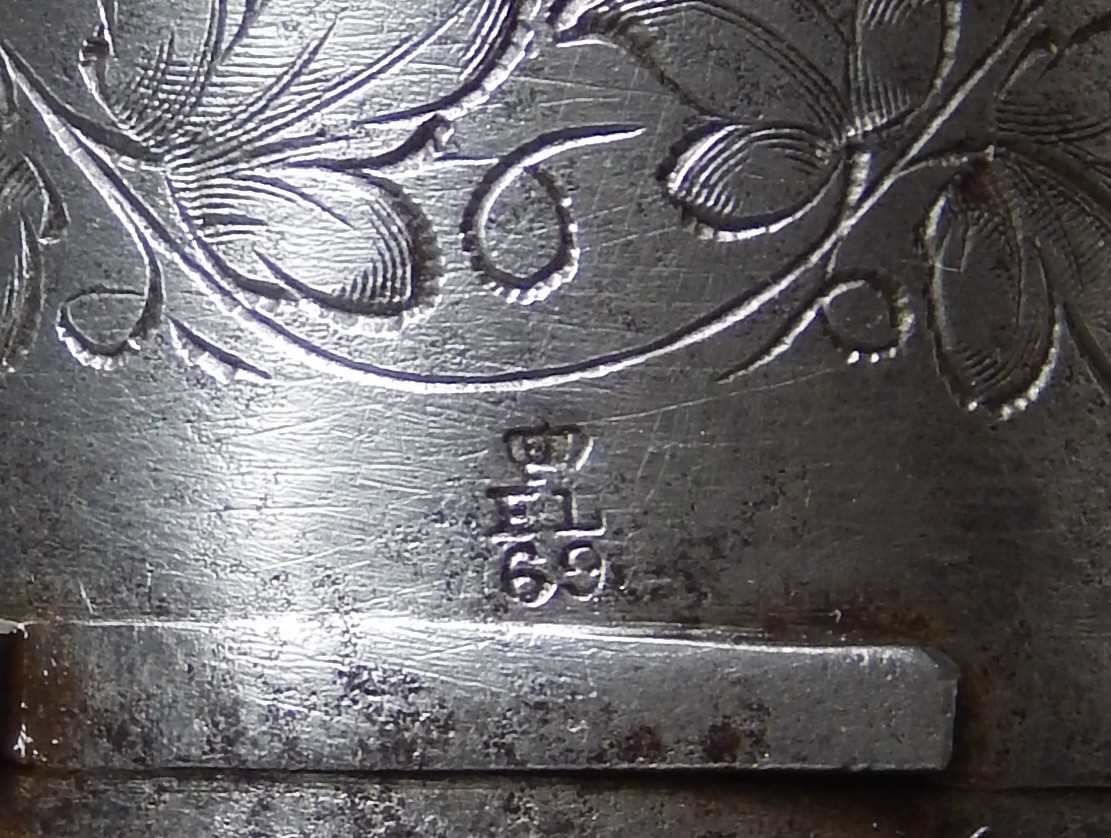
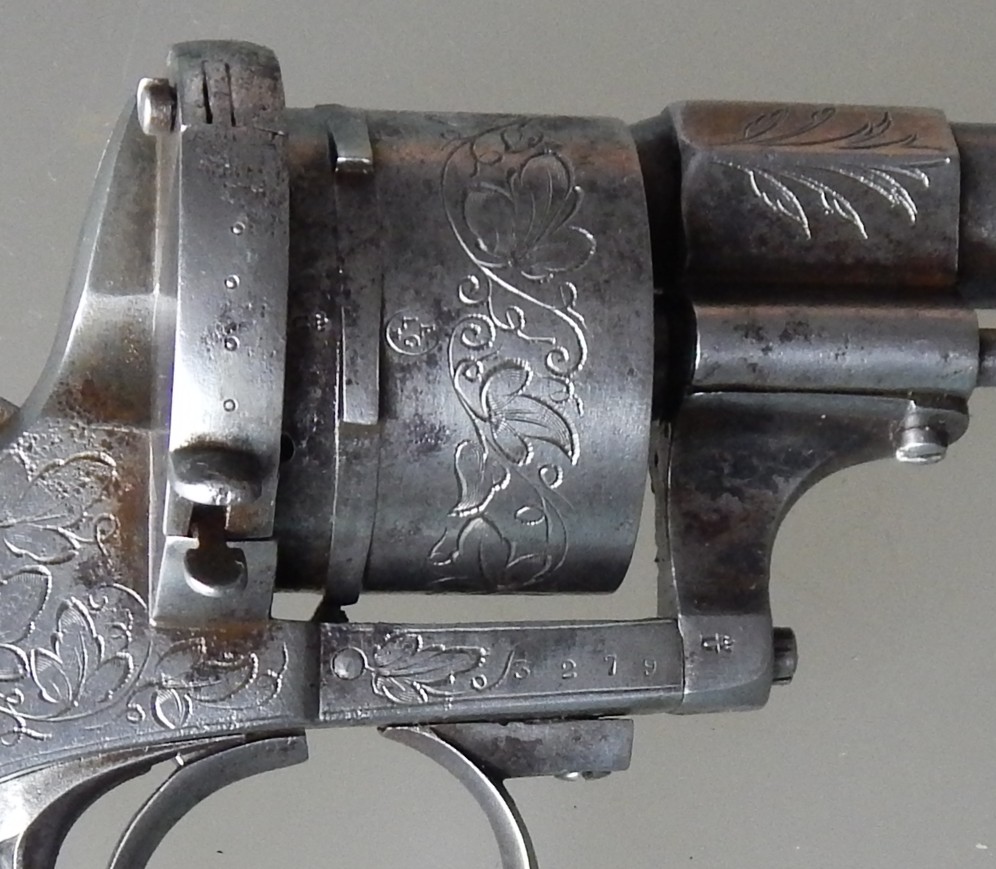
Eugène Lefaucheux
Revolver
Lefaucheux
“Belgian” EL 163785.
Caliber 7 mm, made by
Lefaucheux
in its factory in Liège in the first half of 1867.
Guillaume
Eugène Lefaucheux (Bull Dog)
|
A Revolver Bull Dog by Lefaucheux
Markings:
ELG and B starred on
the barrel
R crowned and B
starred on the carcass
Serial number 817
and logo Lefaucheux on the heel of the handle
Calibre 11mm73
Comments:
Lefaucheux sold some
Bull Dogs revolvers as shown in the 1886 catalogue (photo 3). We find
mainly Puppies in European calibres 320 and 380.
Much rarer is this
bronzed specimen in French regulatory calibre 11mm73. Made in his
workshop in Liège, it wears its LF logo surmounted by the “broken
pistol” Equipped with a full cylinder, it is a well finished revolver
with beautiful dark wood grips (ebony?) partially grided at the back.
This last feature was not only aesthetic, as it helped to keep the small
handle in hand.
Jean-Christophe Plaquevent |
Eugène Lefaucheux
This is
no doubt a revolver belonging to Colonel Le Mat with a spindle. The gun has two
barrels, the striated and ripped top is connected to the 9-mm 9-mm spindle
barrel, while the smooth round central barrel is 12 mm percussion. Le Mat is the
inventor of the revolver and rifle system which bears his name and which was
manufactured in France and Belgium in several models (see his profile on our
website).
The
weapon bears a mark from the Liège test bench, namely:
Crowned
Y: Controller’s countermark, in use from 1853 to 1877.
The ELG*
punch in a vertical oval should logically be on the gun, but I didn’t see it? Is
this the definitive acceptance mark used from 1846 to 1893?
The
weapon also bears the following markings:
The crowned EL: this is undoubtedly the trademark of
Eugène
Lefaucheux’s Liège factory, which was based
in Liège quai de Fragnée 13 from 1866 to 1872. This workshop manufactured not
only Lefaucheux weapons but also weapons of other inventors. However, it is the
first time that I see firsthand that he has made Le Mat, so the proof is made.
Number 1
on the barrel: either a serial number or a workshop number?
Colt
Lemat Bte: Mark of Colonel Lemat inventor of this weapon. He was a doctor and
lived from 1824 to 1881. From 1857 to 1871 he filed 6 patents in France and 6
patents in Belgium.
GG
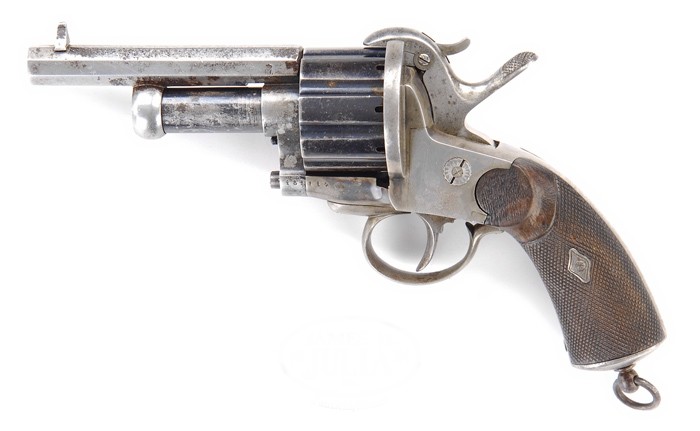
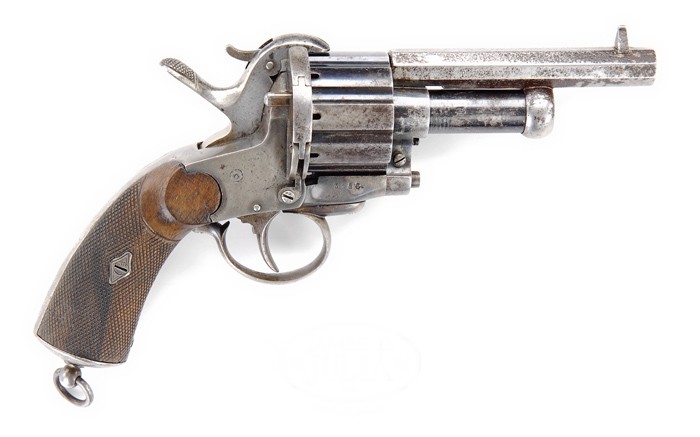

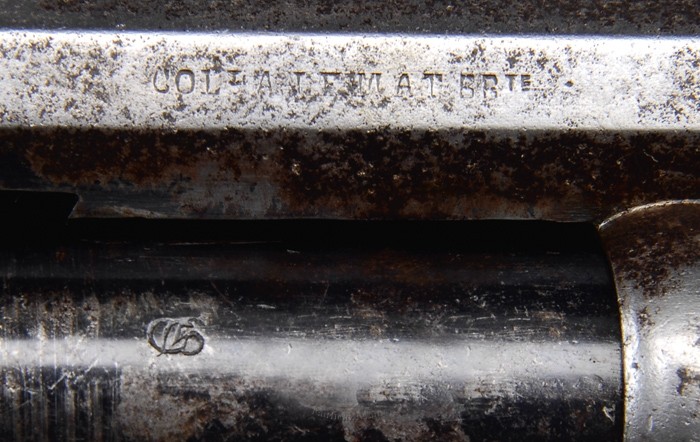
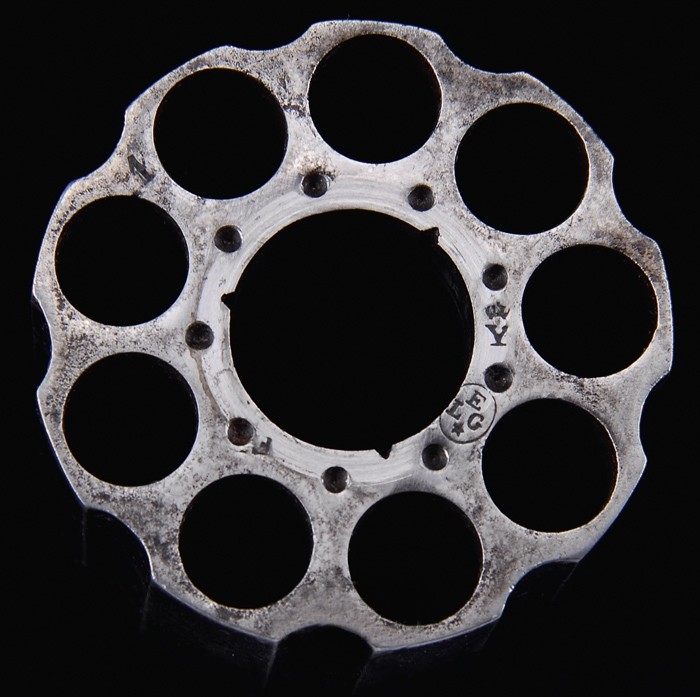
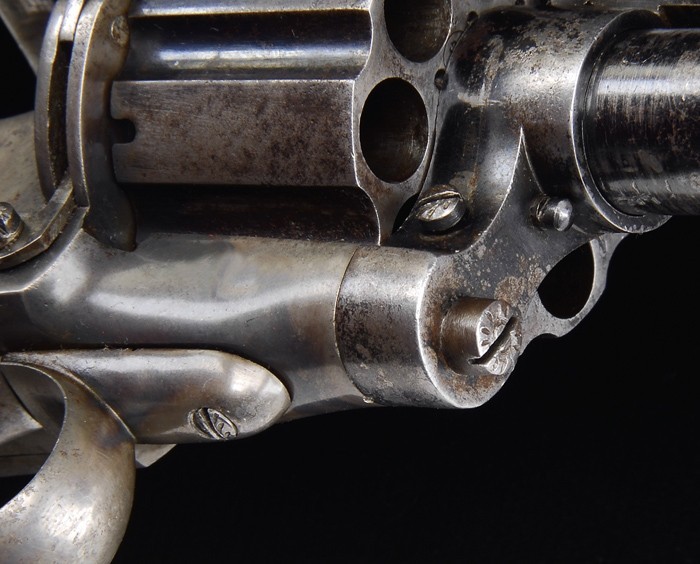
Eugène Lefaucheux
Il s’agit ici d’un très classique revolver de poche, type Lefaucheux à broches. Le barillet lisse est à 6 coups et est cranté pour recevoir les broches. Le canon rayé est à 8 pans avec un guidon type grain d’orge. Le cran de mire devrait être creusé dans la tête du chien (non visible sur les photos). La détente est lisse et sans pontet, elle est repliable sur la carcasse pour faciliter la mise en poche. La portière de chargement sur le flan droit est manquante. Les crossettes sont en bois quadrillé et maintenues par une vis centrale et deux rosettes.
L’arme porte les poinçons réglementaires du banc d’épreuves de LIEGE, soit :
ELG* dans un ovale vertical : acceptation définitive, en usage de 1846 à 1893.
M* : contremarque du contrôleur en usage de 1877 à 1968.
Elle porte également les marques suivantes :
EL couronné (si bien lu car partiellement effacée) : il pourrait s’agir de la marque de l’entreprise d’Eugène LEFAUCHEUX quai de Fragnée, 13 à Liège qui a été opérationnelle de 1867 à 1873. L’entreprise ayant été en liquidation pendant plusieurs années, cela explique « peut-être » la discordance de dates (1873 et 1877 ??).
LDR sur un montant de crosse : il s’agit vraisemblablement de la marque d’un sous-traitant liégeois non identifié ?
19 11 : (si bien lu) : il ne s’agit pas d’une date (chiffres trop écartés) mais bien d’un numéro de série (19 ?) et peut-être d’un numéro d’atelier ?
GG
Eugène Lefaucheux
Revolver
pinfire that seems to me to be in 7 mm simple and double action of Belgian
manufacture, the crowned N and the ELG marks in its oval proves it.
N crowned
= before Jan 1877.
The
number of the gun (160266) appears, according to our records, to indicate
manufacture in 1866 (subject to reservation and without being able to be more
precise).
The
crowned EL proves that the weapon has passed through Eugène Lefaucheux’s
workshops in Liège, for finishing and/or assembling and for which the
manufacturer/assembler and/or reseller paid the royalties, the “E. Lefaucheux
Inv Breveté” proves this.
JS
underneath the grips, letters already observed on weapons coming out of the
workshops of Lefaucheux, are surely from a worker or the assembler of the
weapon.
Guillaume
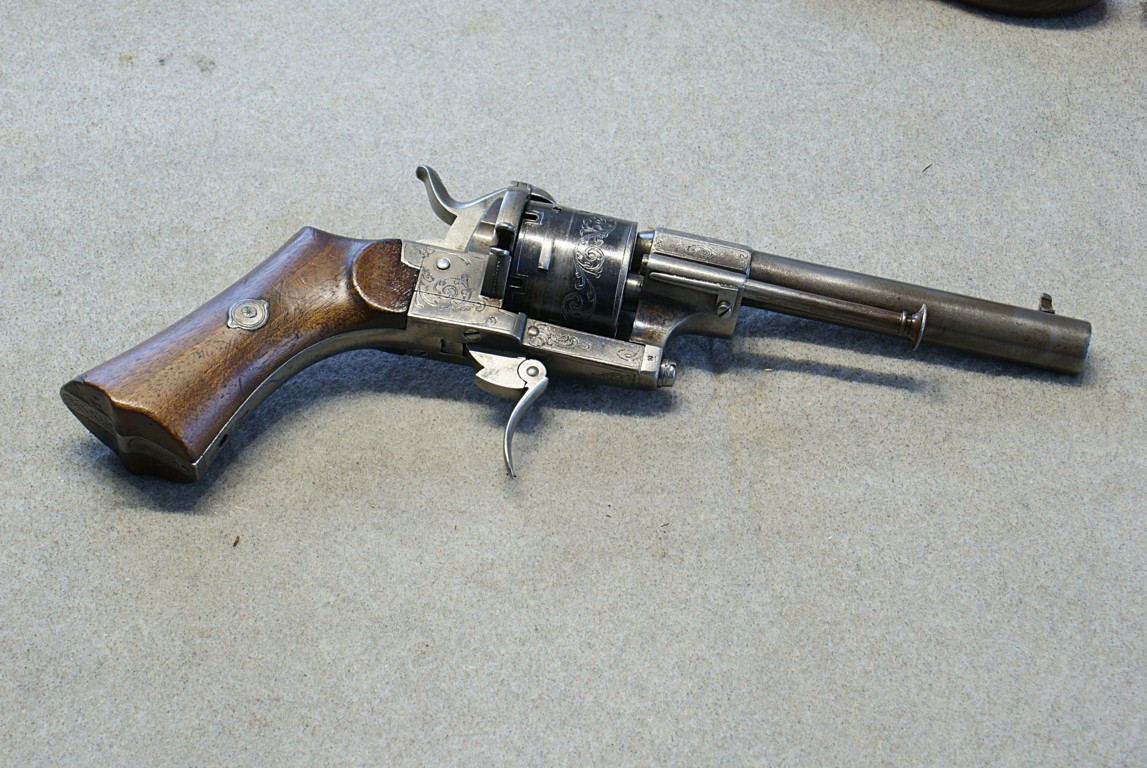
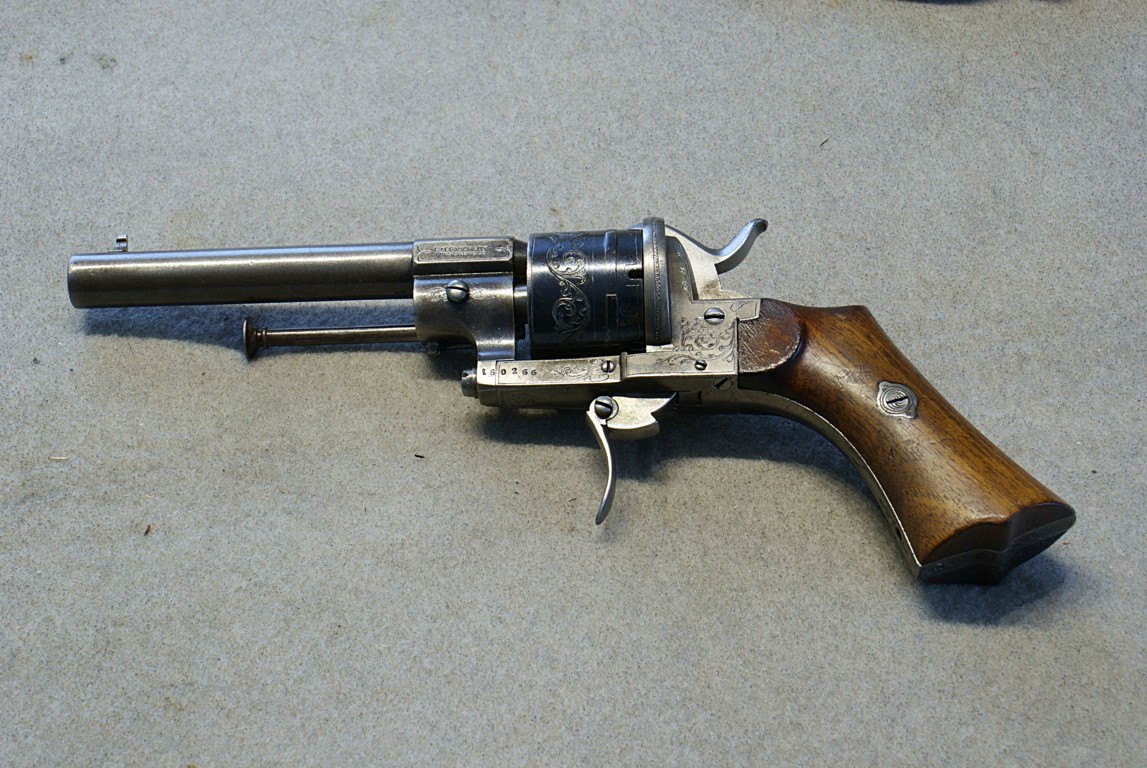
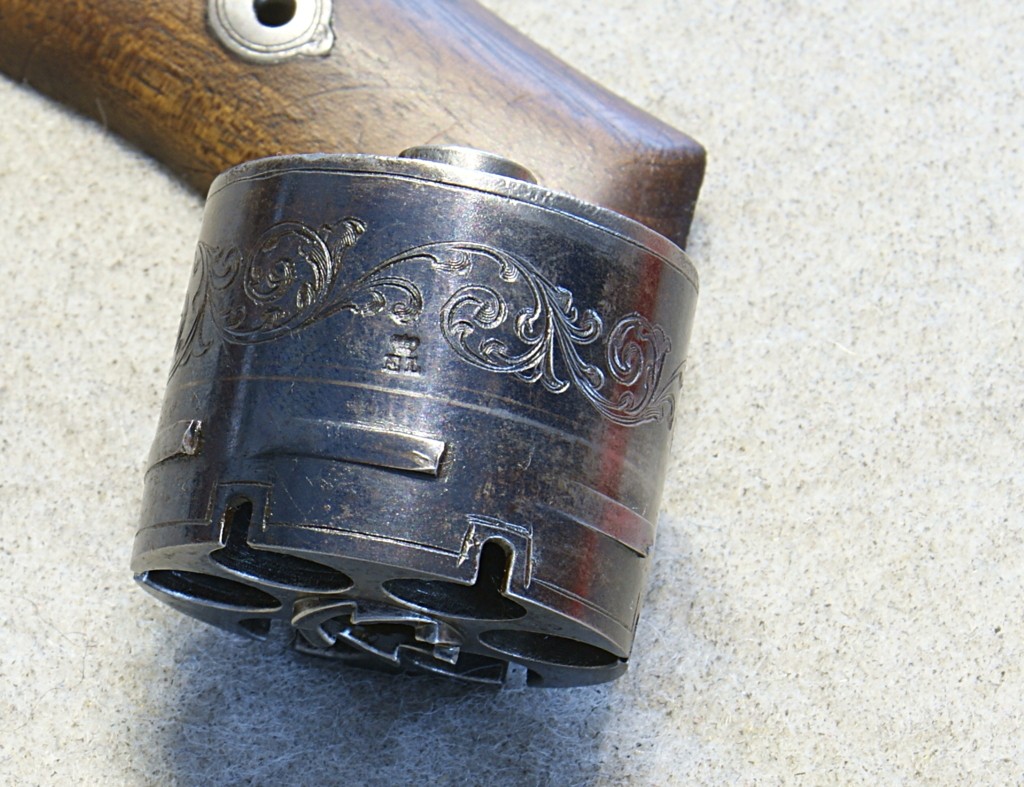

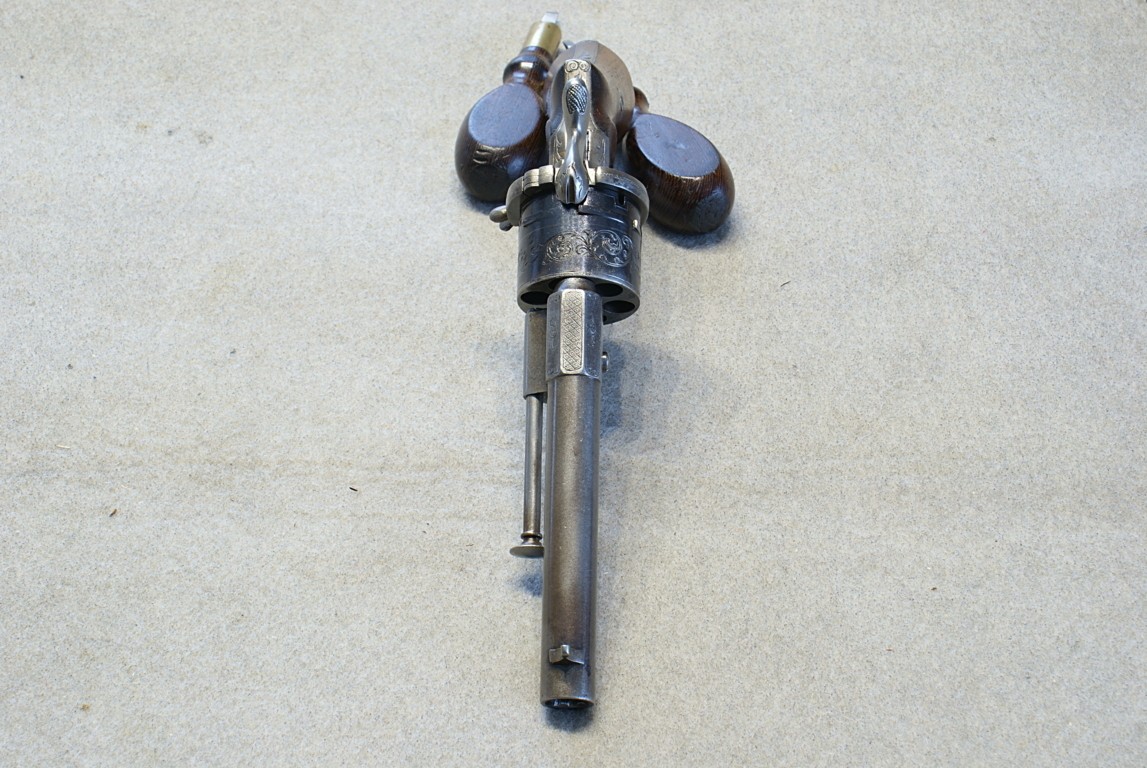


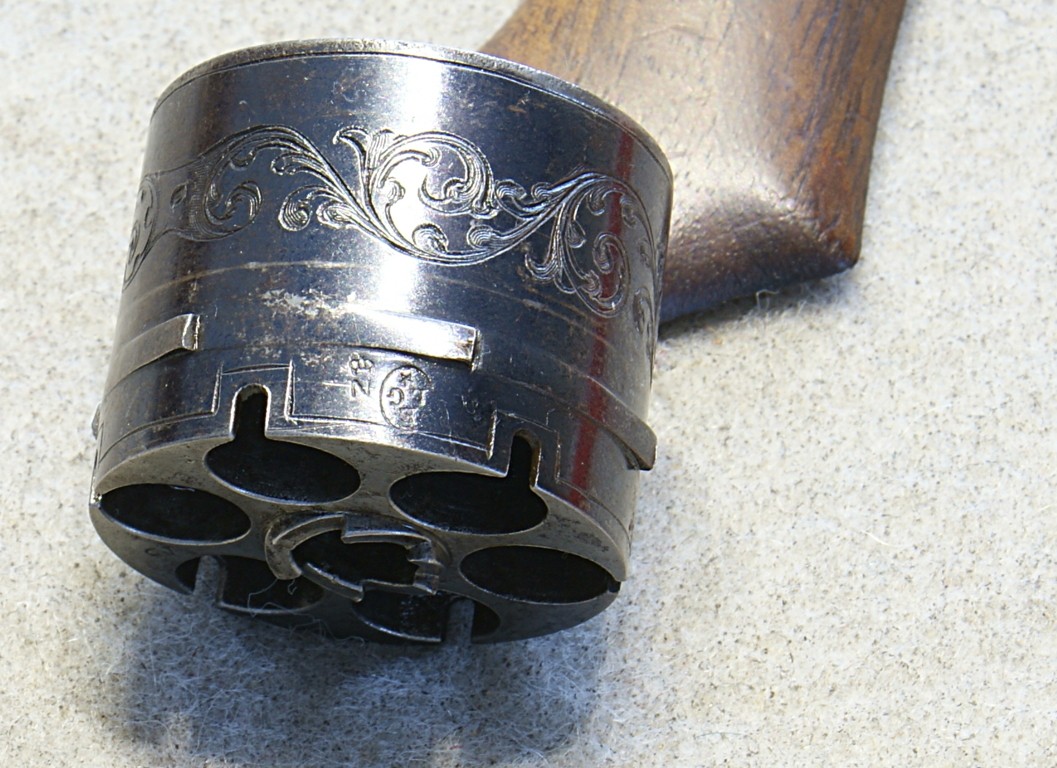

Eugène Lefaucheux
Revolver 1854 called "Heavy Version". Flat oval heel and round bridge.
12 mm, 6
chamber pinfire.
Single
Action mechanism.
The LF
111842 was probably made in Lefaucheux's workshops in Liège, in white, and
shipped to Paris for assembly, finishing and marking in the workshops at 194 rue
Lafayette.
The
manufacture of this weapon is to be located towards the end of 1871 (October /
November probably).
The
number of assembly is a number + a letter and is present on the whole of the
parts.....door, internal face of the cylinder, barrel, internal face of the
breech, under the plates of grips.....
The
easiest places, it is on the internal round of the loading door, or by keeping
the door open and one makes turn the cylinder......
We are
persuaded that these numbers and letter have a logic but has part its role of
assembly marker we do not know.
Why a
number and a letter, why not just a letter or just a number, mystery.......then
we write them down and maybe one day we'll know what they're for!
Guillaume
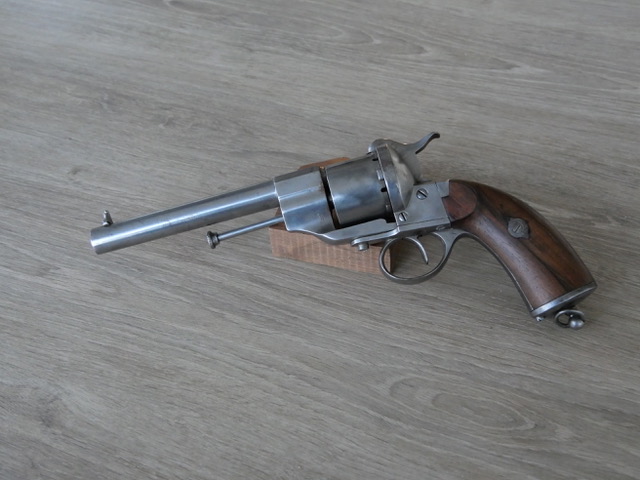
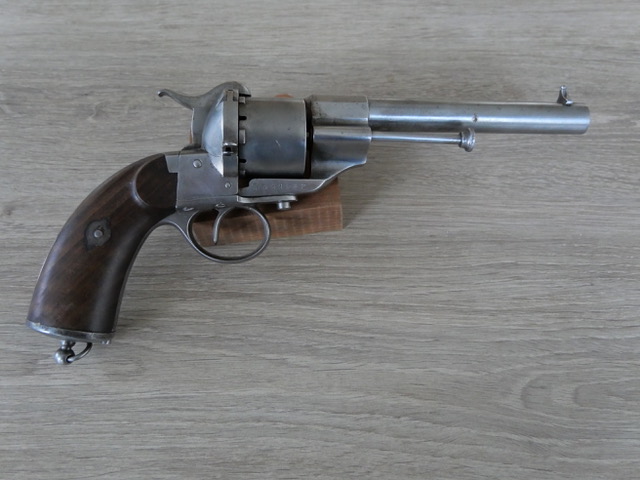
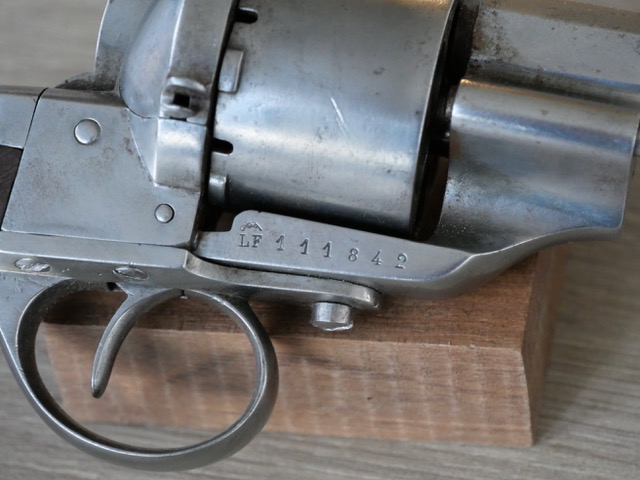
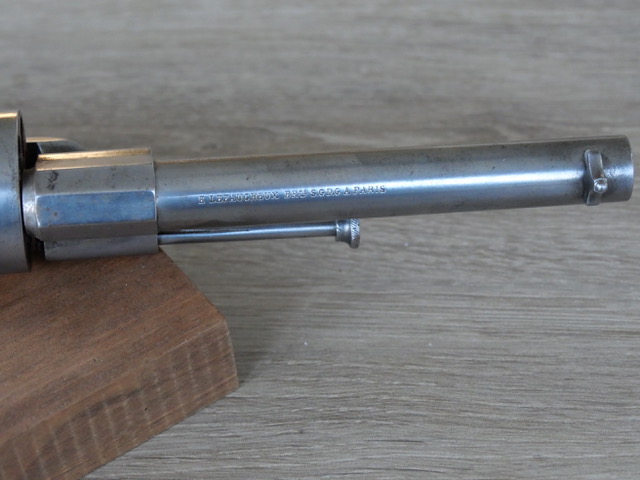
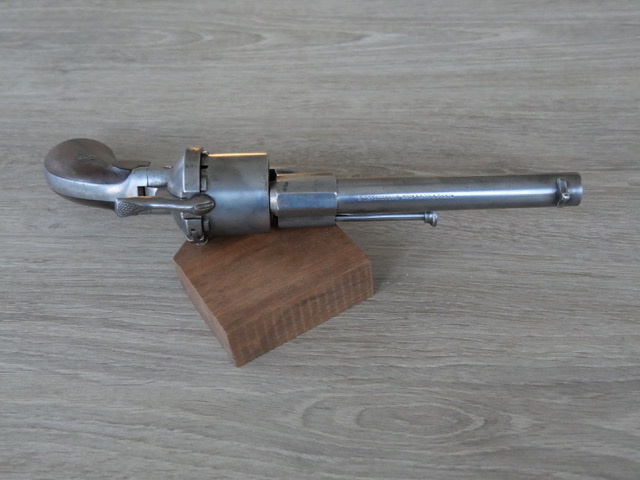
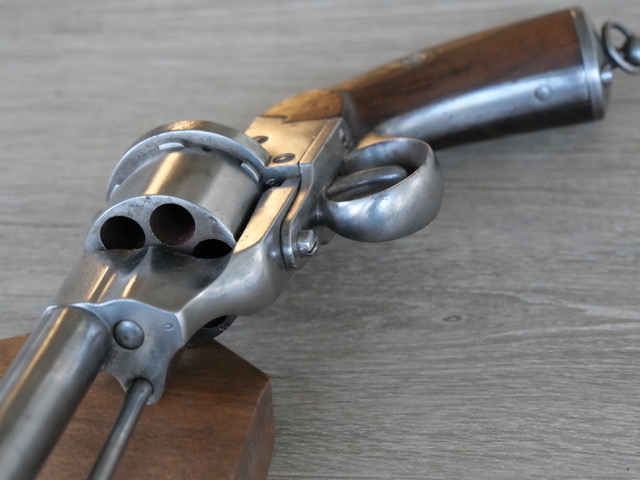
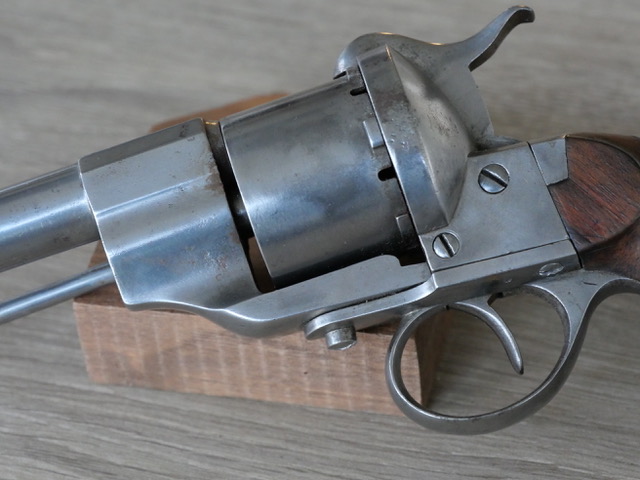
Eugène Lefaucheux
This rifle revolver is with pin and open frame.
The cylinder is not grooved, the hammer is flat and the trigger guard with volute.
The sight is adjustable.
The English stick is in walnut.
The barrel is with 8 sides. The loading is done by the door located on the right side of the frame while unloading is practiced thanks to the metal rod fixed under the barrel.
Fasteners - strap are fixed on the barrel and the stock.
Photographs letting me see that only one mark of the proofhouse of Liege is spangled ELG in an oval which is the mark of acceptance of 1846 to 1893.
The mark of crowned manufacturer EL is that of Eugène LEFAUCHEUX.
GG


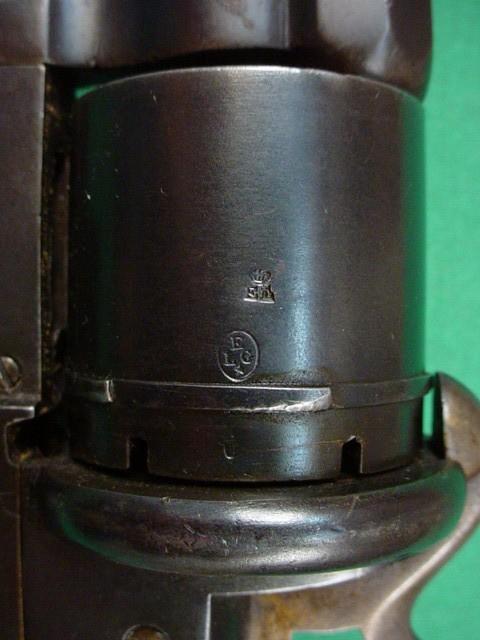
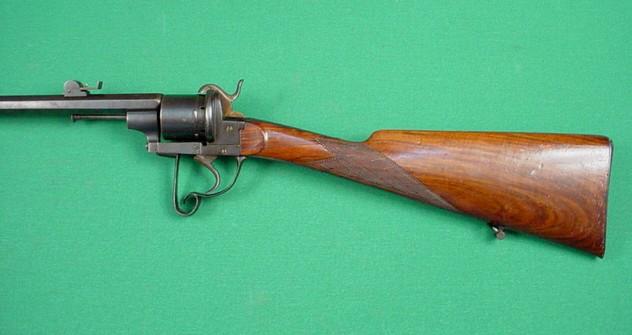
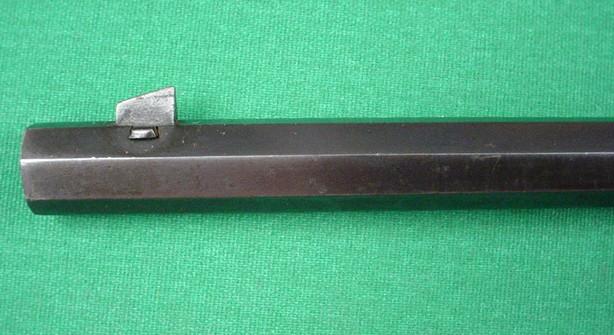
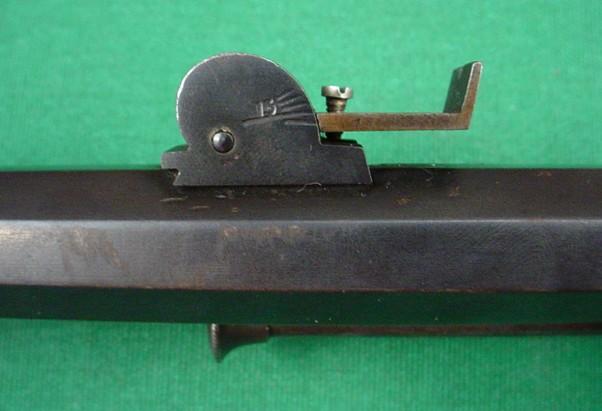
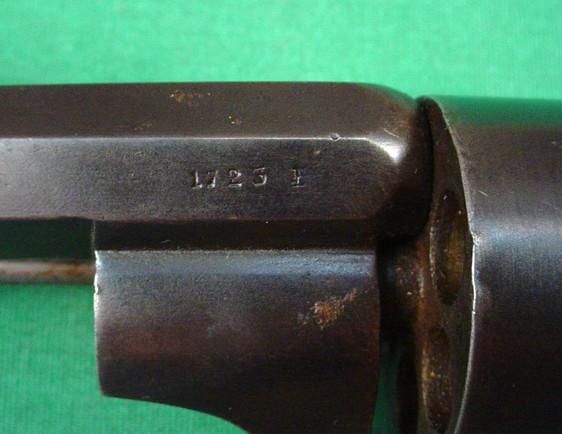
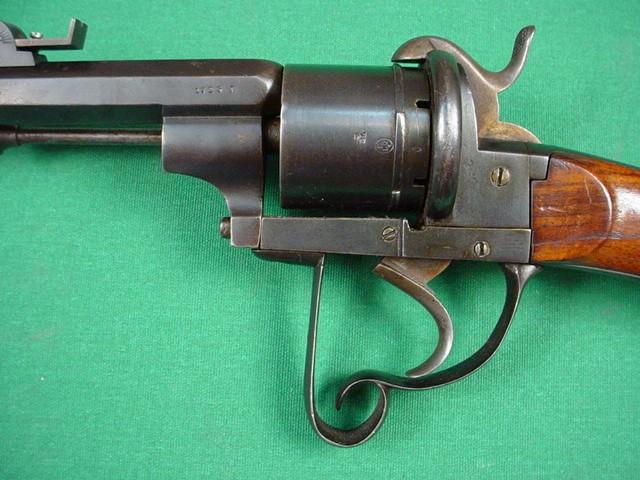


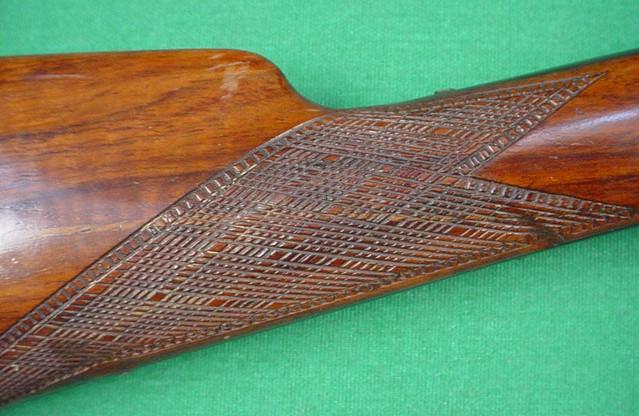
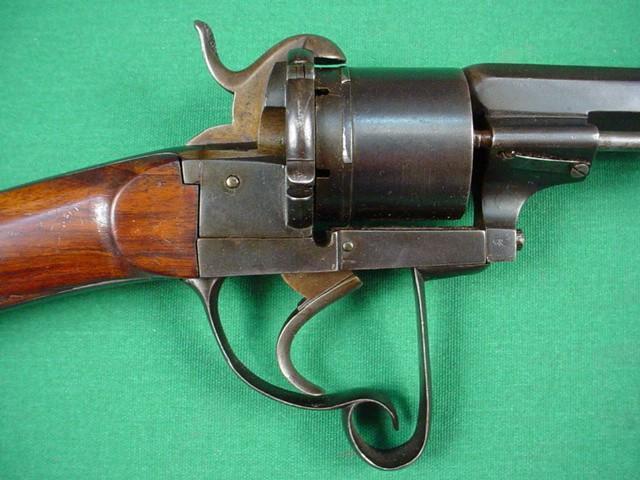
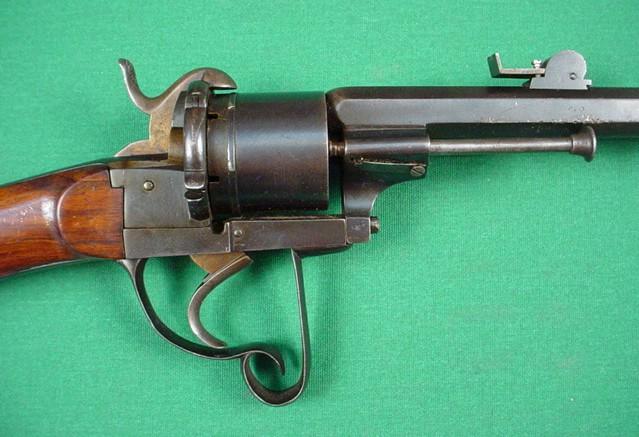
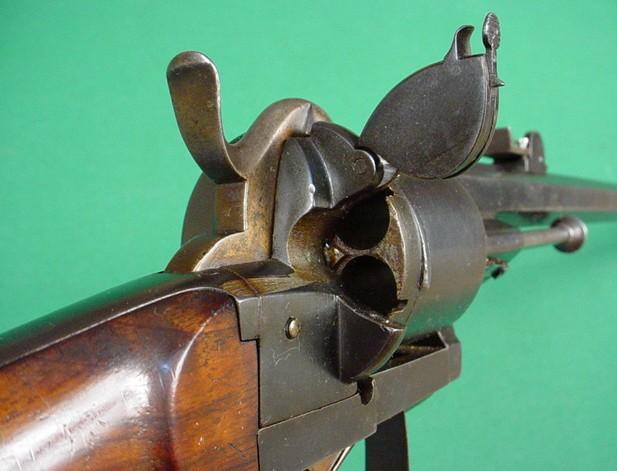
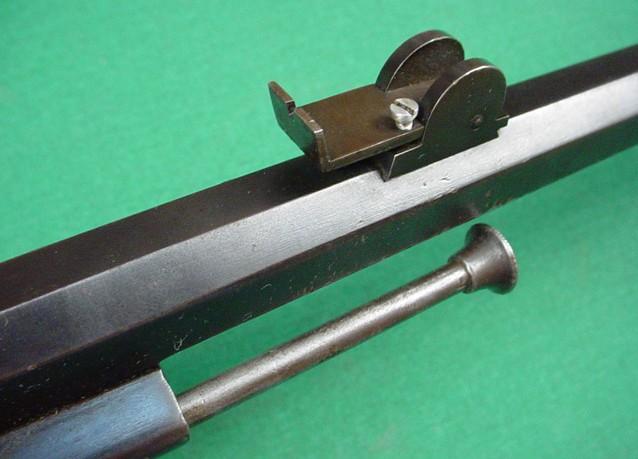
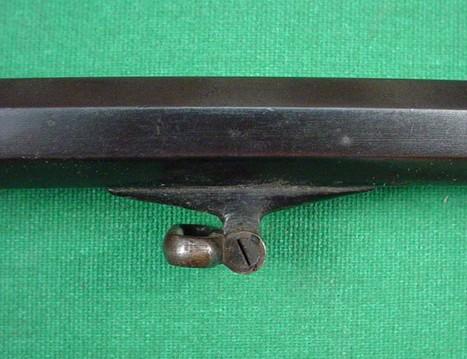
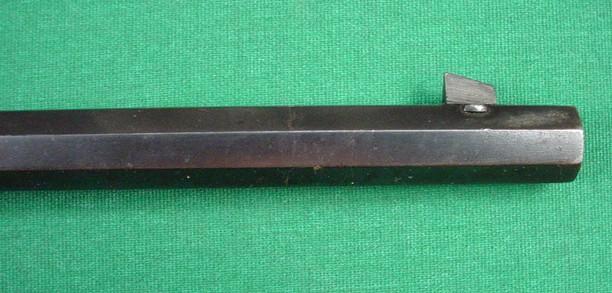
Eugène lefaucheux
Revolver of pocket pinfire of caliber 7 mm, with folding trigger, recut peak of hammer and cylinder not grooved with 6 shots.
The rod is installed on the left of the barrel, this weapon is thus of a model later and answering the specifications of the patent n° 14955 of the 07.09.1863.
The completion in is luxurious with an engraving in hollow bottom and grips with engravings in molded horn or seem to me does gutta-percha about it?
All the part is covered with a fine gilded layer of which I am unaware of the origin (gold plating to the bath or other?).
This weapon carries the nickname of “left-handed” among the collectors although it is intended to the right hand.
Mention CHAMELOT et DEVIGNE Breveté refers to the first patents n° 12.861 of the 07.07.1862 and n° 13241 of the 27.09.1862 deposited in Belgium by it and their representative CH. FUSNOT in Brussels.
Although French, DELVIGNE made manufacture his weapons by companies of Liège such as PIRLOT Frères, FALISSE & TRAPMAN.
This weapon carries the EL crowned mark which is that of Eugène LEFAUCHEUX.
It also carries a punch of the proofhouse of Liege is spangled ELG in an oval which is the mark of acceptance, used of 1846 to 1893!
GG
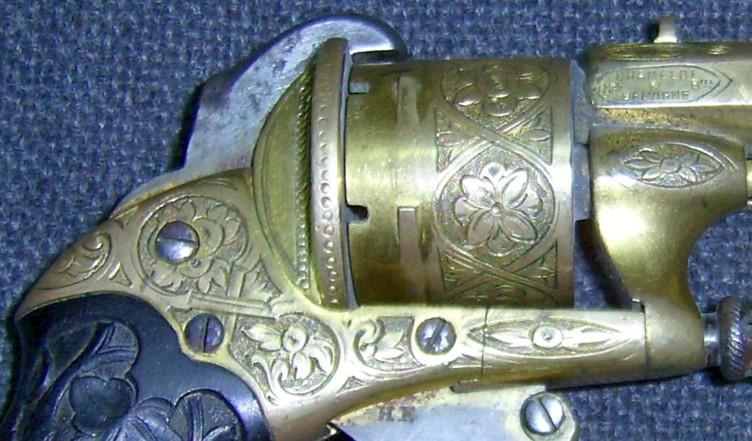


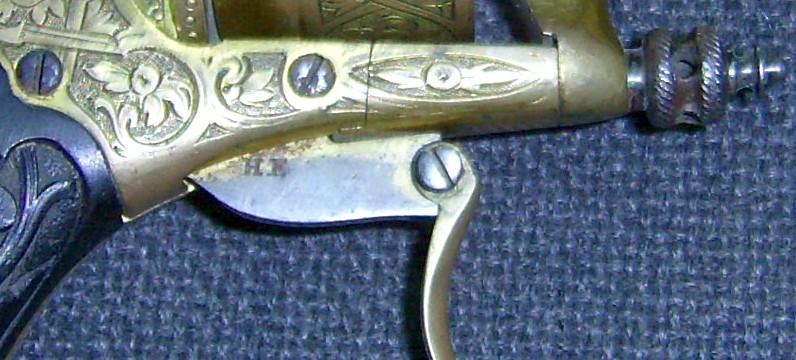
Eugène lefaucheux
The weapon
It acts of a traditional revolver, pinfire and open frame. The cylinder is full without grooves. The door for the cartridges is on the left-hand side of the carcass. The rod is aimed in the handle and the grips are in walnut dye sticks fixed by a screw at rosette. The trigger is folding without trigger guard.
The front sight is raised to allow the aiming when the hammer is armed.
The manufacturer
Crowned mark EL belong to Eugène Lefaucheux.
Inventor
ARENDT Maurice, street Trappé, 8 in Liege were registered with the proofhouse of 1857 to 1889, it is the author of ten Belgian patents deposited of 1864 to 1885 in particular for improvements with the Lefaucheux system.
GG
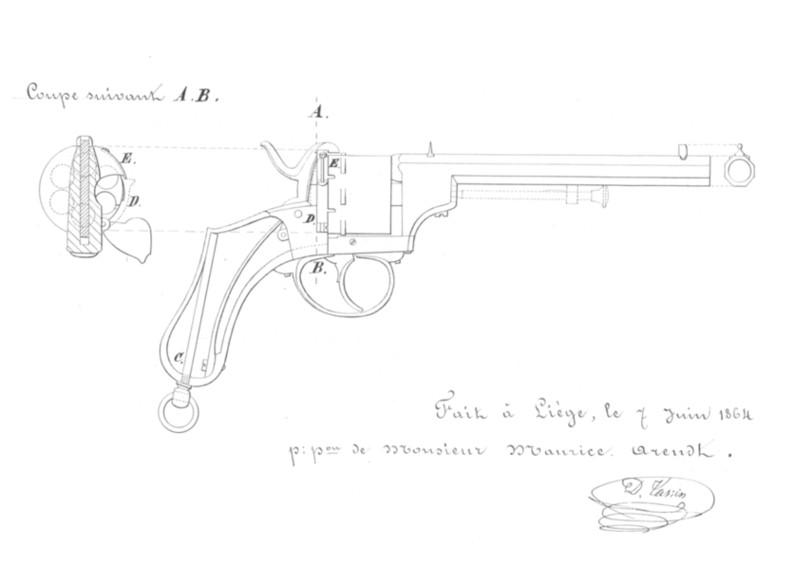
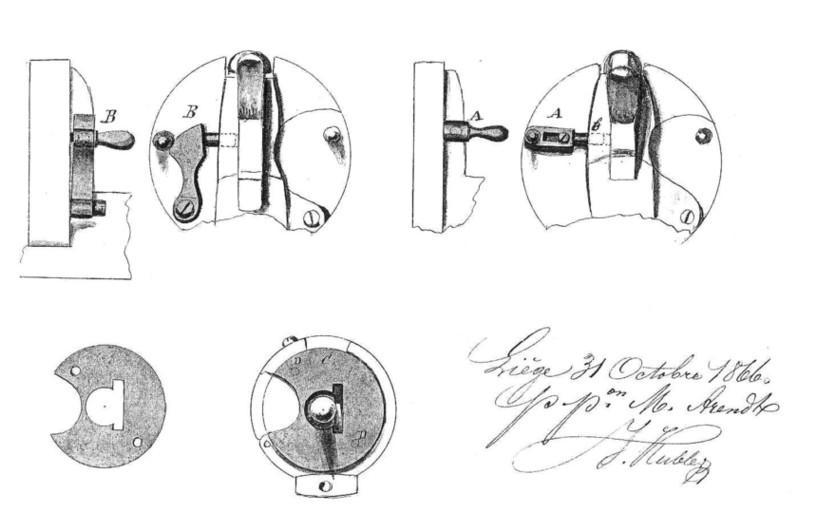
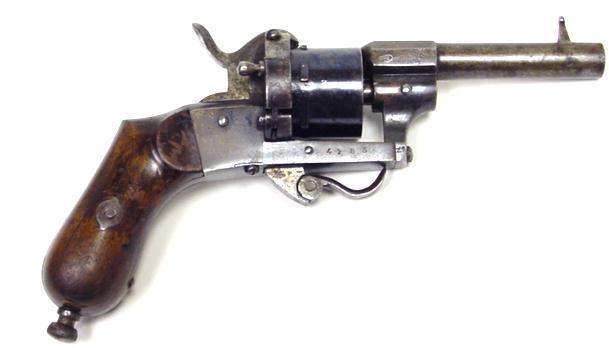
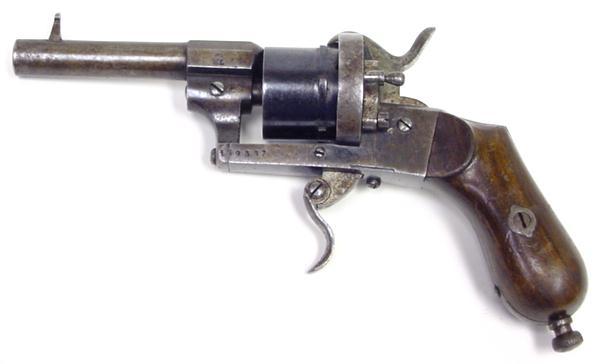
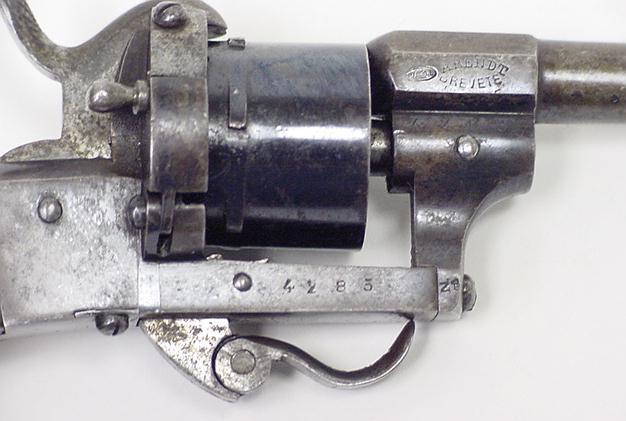
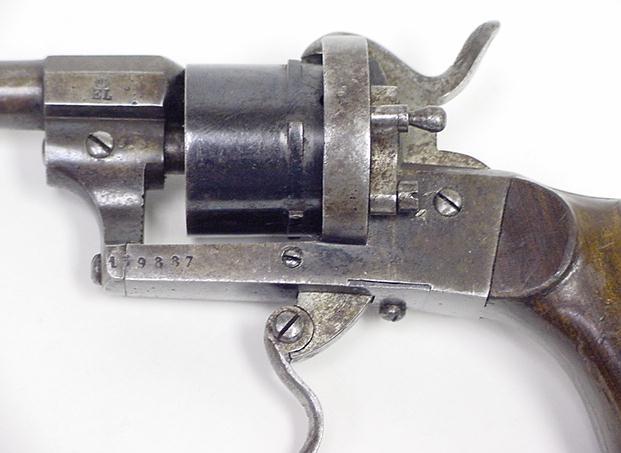
Eugène lefaucheux
Very scarce Degueldre - Lefaucheux pinfire revolver. Very interesting modification of the basic Lefaucheux design. The barrel assembly and cylinder moves 1.25 inch forward for unloading, when the lever located on the right side of the barrel is turned down. Unusual design of the frame without the loading gate, which was replaced by "L" shaped spring that secures cartridges in the cylinder.
Large frame, open-top design. Six shot cylinder.
Very nice dark walnut two-piece wooden grips with diamond checkering. Six inch long octagonal barrel.
Maker markings are present on the left side of the barrel housing, "Crown over EL" (Eugène LEFAUCHEUX). Right side of the barrel housing is marked, "Crown over X, DEGUELDRE BREVETE".
House of Liege proof is present on the cylinder.
English pressure test Birmingham proof marks are stamped on each chamber of the cylinder, as well as on the barrel. This may indicate that the revolver was manufactured for English market.
Single and double action.
Many thanks to “COLLECTIBLEFIREARMS” for the nice pictures.
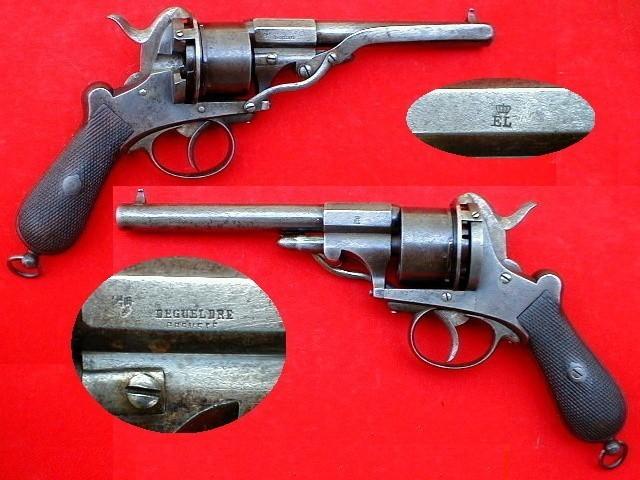


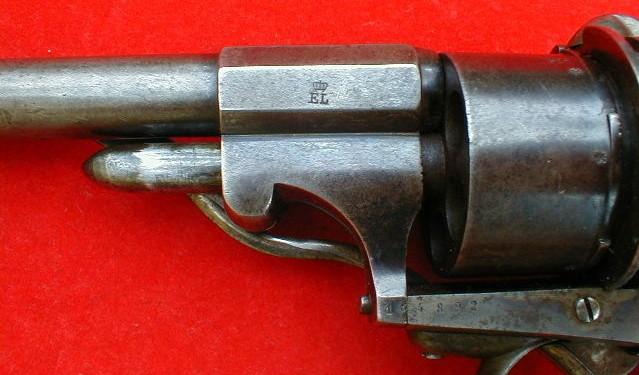
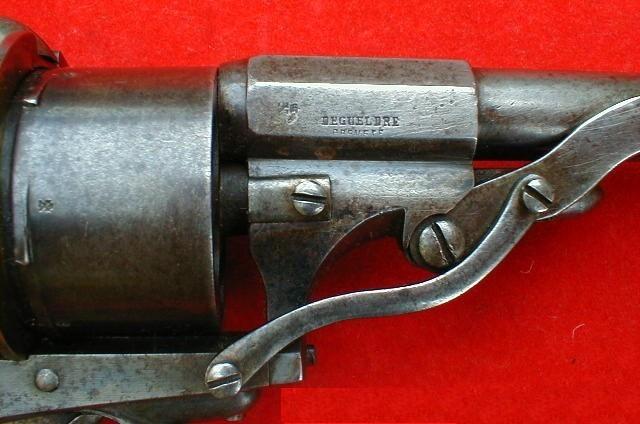
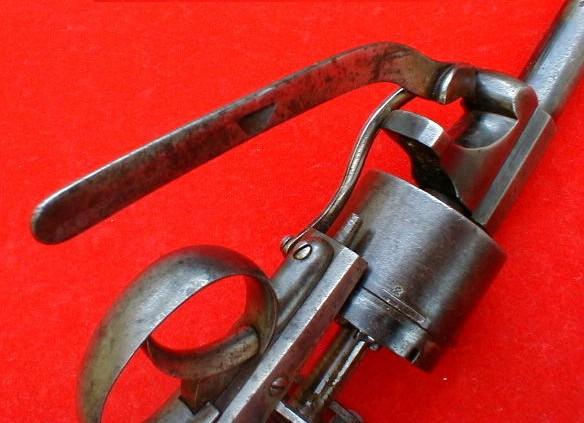
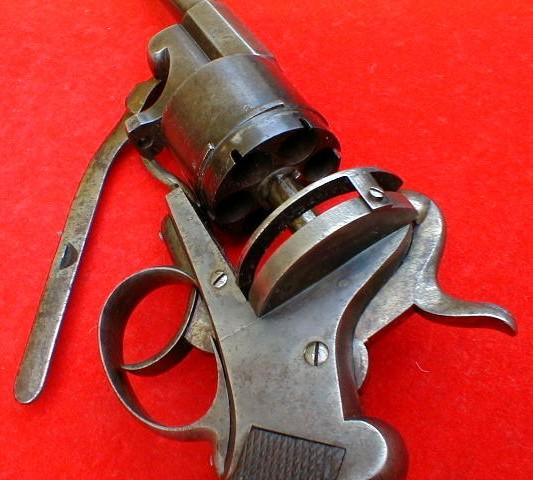
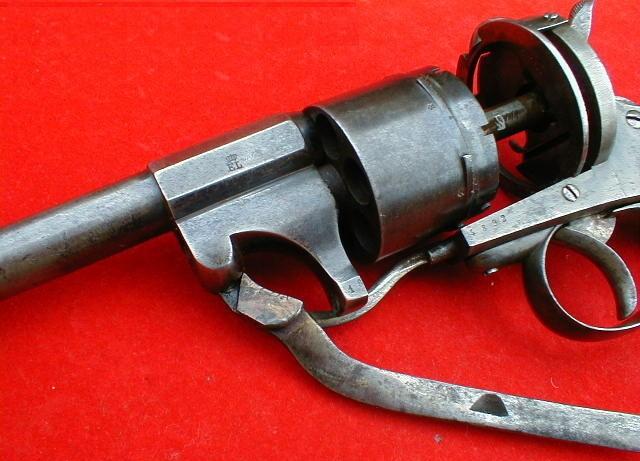

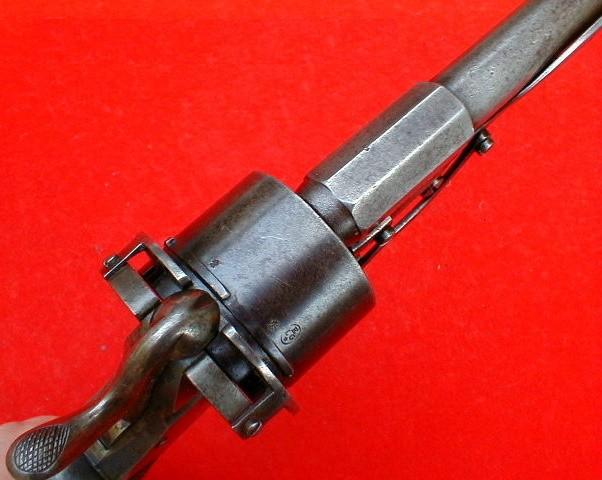
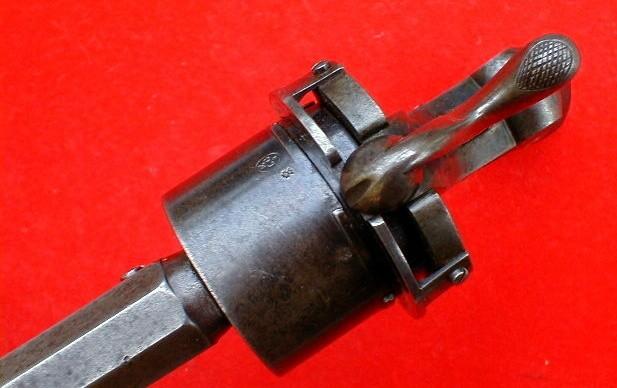
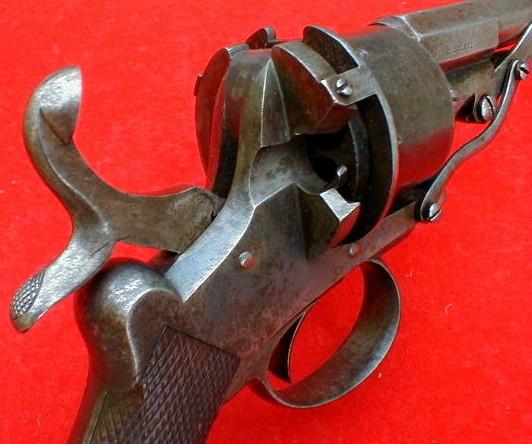
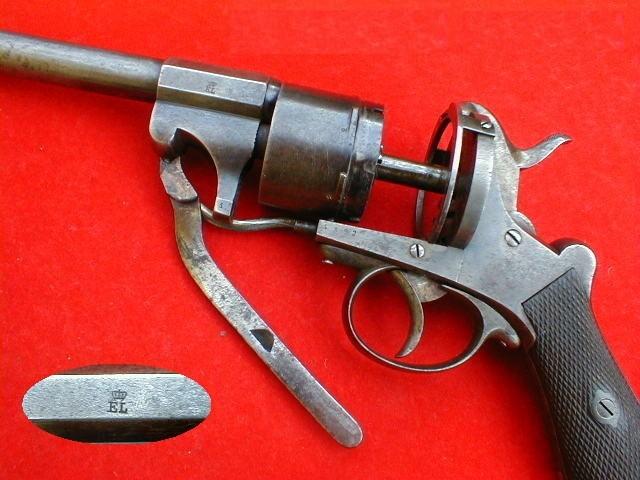
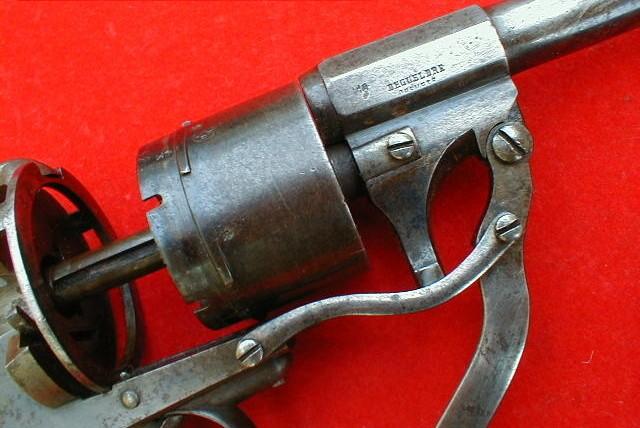
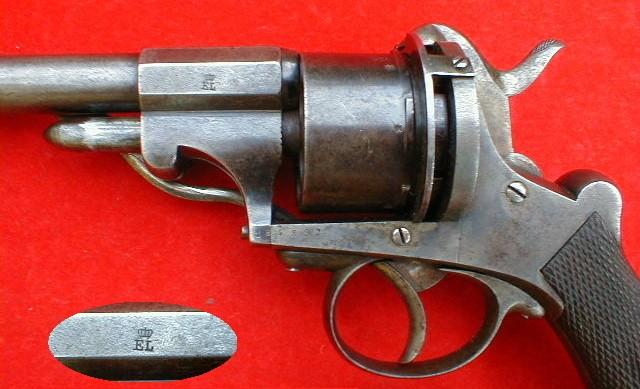
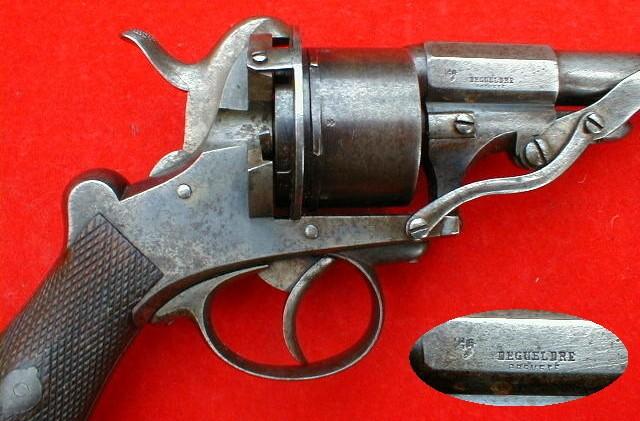
Eugène Lefaucheux
Marking E.LEFAUCHEUX INV BREVETE (Patent) with the left thunder is without question the confirmation that this weapon comes well from the Manufactory E.LEFAUCHEUX
Located in LIEGE quay of Fragnée, n° 13 of 1867 to 1873.
The n° 203525 is a job number of not to doubt well that it is rather high!
If the series began with figure 1 that an idea of the production of this small factory gives us.
EL crowns 67: it is about a marking often raised on the weapons Lefaucheux of Liège.
The same mark with the n° 68 was also seen.
Is it about the mark of Liège of Eugene Lefaucheux as it had some for his factory in Paris?
It’s trying to believe it but confirmation will have to be awaited.
In the same way are figure 67 and then 68 years of manufacture??
The manufacture of Liege having started to produce in 1867 that seems probable. It would be necessary to be able to examine others weapons Lefaucheux of Liège to raise the dates and to confirm or cancel this assumption of them!
Invitation is launched to the readers!
Other markings belong to the proofhouse of Liege, namely:
ELG on star in an oval: final acceptance, of use of 1846 to 1893.
N under crown: countermark of the controller, of use of 1853 to 1877.
On the other hand, the partially unobtrusive oval mark struck between two parts of the carcass leaves me perplexed, it does not belong to the proofhouse and I’m unaware of the significance of it?
Could this almost illegible mark be PIRLOT BROTHERS? (see below)
GG
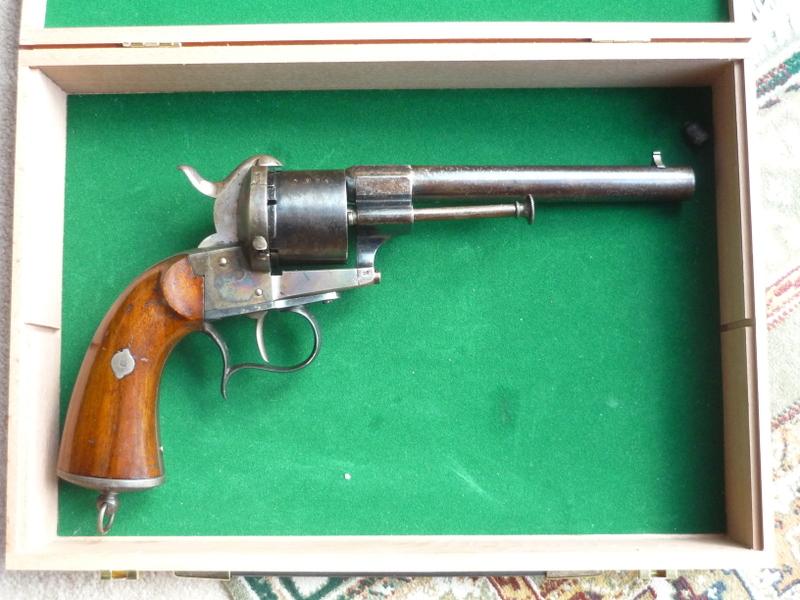
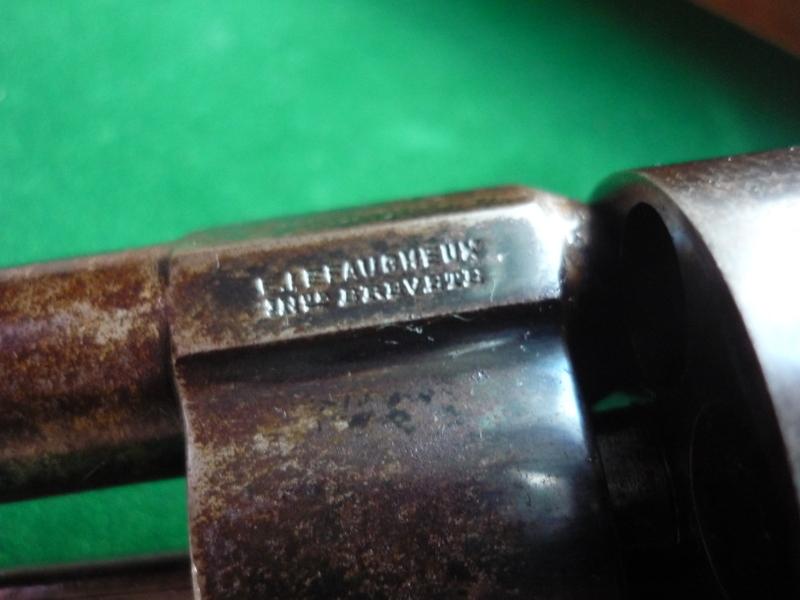
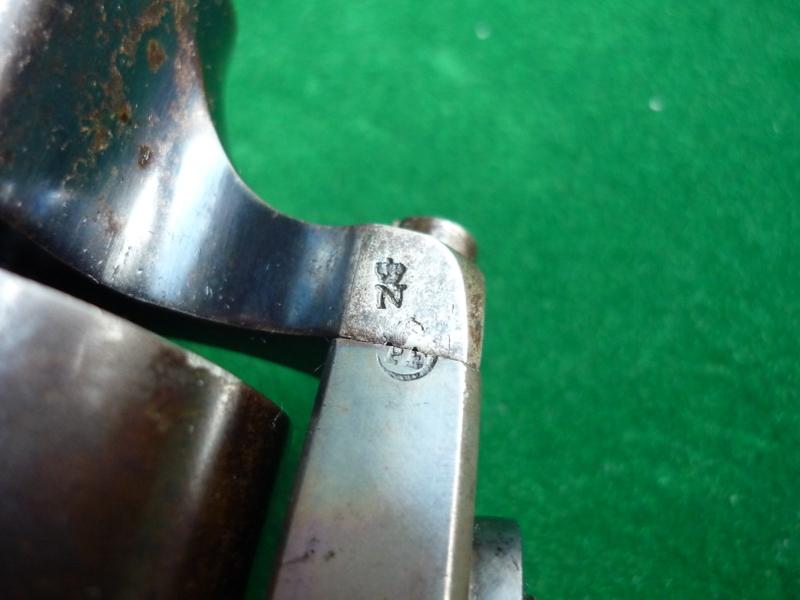
![]()
Mark of Pirlot !?

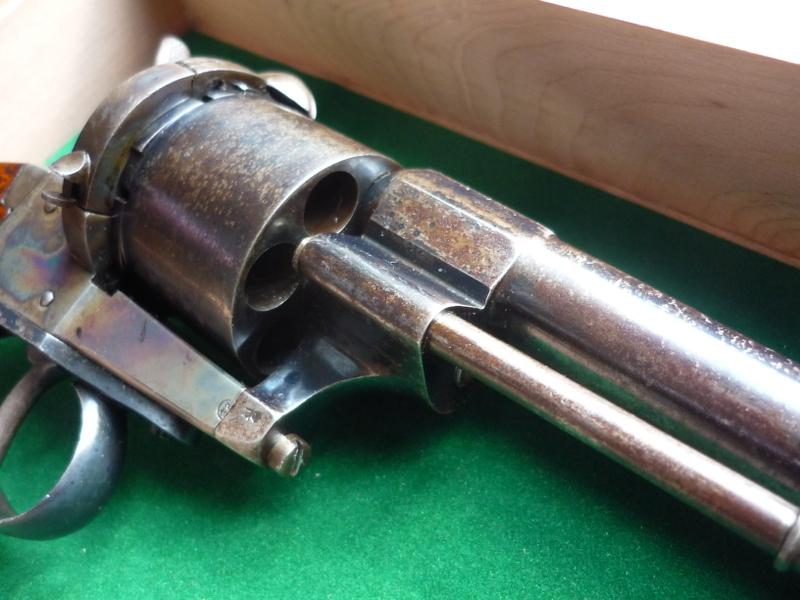
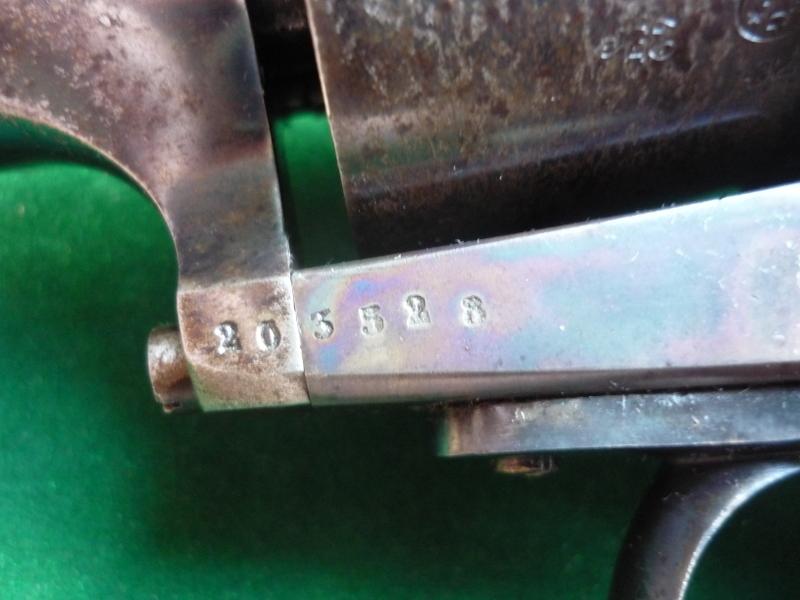
Eugène Lefaucheux
It is indeed about a revolver E.LEFAUCHEUX abundantly described on the site, will thus not return us there.
The weapons manufactured by the Manufacture d’Armes Eugène Lefaucheux (Manufactory of weapons Eugene Lefaucheux) quay of Fragnée, 13 in LIEGE (active of 1867 to 1873) always carry to the left thunder mention E.LEFAUCHEUX INV BREVETE (E.LEFAUCHEUX INV PATENTS) like this specimen.
The weapon carries moreover punches of the test of Liège, namely:
ELG on star in an oval: final acceptance of use of 1846 to 1893.
X under crown: countermark of the controller of use of 1853 to 1877.
Mark EL under crown was in my opinion, but I don’t have of it yet confirmation, the mark of Eugene Lefaucheux intended for the factory of Liege.
The fact that the barrel is in two parts is never considering, it thus remains to us the assumptions, namely:
- It is about a weapon intended for South America where the short barrel weapons were prohibited. Was the addition of an end of barrel to be screwed/unscrew to be sufficient so that the weapon passes the customs?
- It’s about an assembly intended to lengthen the barrel and to make a rifle of it?
Is there a mortise of fixing of a stick on the back part of the grips?
GG

